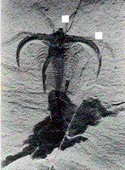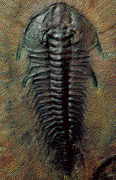Marella splendens
 Marella is the most abundant and the most common arthropod found with over 15,000 specimens found. It was a deposit feeder that fed on organic particles. The body of Marella is divided into 26 segments of which each contains a jointed walking leg and a feathery gill branch, used for swimming. Thus Marella was capable of walking and swimming. The preservation of Marella is quite unique in
that a dark stain is always left behind, usually at the posterior end. This stain is believed to represent the seeping out of body contents during decay.
Marella is the most abundant and the most common arthropod found with over 15,000 specimens found. It was a deposit feeder that fed on organic particles. The body of Marella is divided into 26 segments of which each contains a jointed walking leg and a feathery gill branch, used for swimming. Thus Marella was capable of walking and swimming. The preservation of Marella is quite unique in
that a dark stain is always left behind, usually at the posterior end. This stain is believed to represent the seeping out of body contents during decay.
Olenoides serratus
 Olenoides was a benthic predator and scavenger. This trilobite dug in the sediment for both concealment and to search for food. When it found its prey, Olenoides used its legs to tear the prey and then passed the pieces to its mouth. Preservation of Olenoides is excellent, and complete exoskeletons are common.
Olenoides was a benthic predator and scavenger. This trilobite dug in the sediment for both concealment and to search for food. When it found its prey, Olenoides used its legs to tear the prey and then passed the pieces to its mouth. Preservation of Olenoides is excellent, and complete exoskeletons are common.
Sidneyia inexpectans
 Sidneyia is one of the largest arthropods found and was named by Walcott after his oldest son Sidney. It was a benthic carnivore that walked along the sea floor in search of prey. Gut contents reveal that Sidneyia's diet was primarily comprised of small trilobites and hyolithids (molluscs). About 200 specimens have been documented.
Sidneyia is one of the largest arthropods found and was named by Walcott after his oldest son Sidney. It was a benthic carnivore that walked along the sea floor in search of prey. Gut contents reveal that Sidneyia's diet was primarily comprised of small trilobites and hyolithids (molluscs). About 200 specimens have been documented.
Return to fossil menu
Return to table of contents